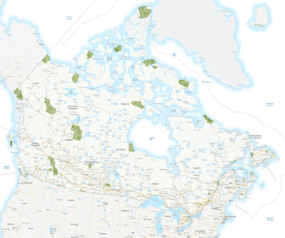Wildlife of Canada facts for kids
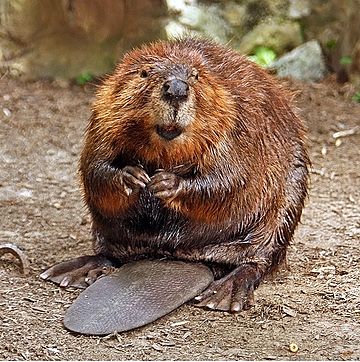
Canada is home to a huge variety of plants and animals, often called its wildlife or biodiversity. Scientists have identified over 80,000 different species here! They think there might be just as many more waiting to be discovered.
Most of Canada's known species are animals (about 68%). Insects make up almost 70% of these animals. Other groups include fungi (16%), plants (11%), and tiny organisms like chromists (4%) and protozoa (1%).
Canada is a big country with many different natural areas. It has fifteen land areas and five ocean areas, each with its own unique environment. The main types of natural areas, called biomes, are the tundra, boreal forest, grassland, and temperate deciduous forest. About half of Canada is covered by forests, which is about 8% of all the forests in the world!
Sadly, due to human activities, new species arriving from other places (invasive species), and other environmental problems, over 800 species in Canada are now at risk of disappearing forever. To help protect these amazing plants and animals, Canada has created many protected and conservation areas.
Contents
Canada's Natural Homes
Different Habitats
- Further information: Geography of Canada
Canada has many different natural homes for its wildlife. These include the thick forests of British Columbia and Central Canada, the wide open prairies of Western Canada, and the cold tundra of Northern Canada. There are also ocean homes along the Arctic, Atlantic, and Pacific coasts.
The biggest ocean area is the Arctic Archipelago, covering about 1.5 million square kilometers. On land, the largest area is the Boreal Shield, which is about 1.9 million square kilometers.
Canada's main natural areas are the tundra, boreal forest, grassland, and temperate deciduous forest. British Columbia has even more types of habitats. These include subalpine forests (high up in mountains), temperate rainforests along the coast, and even a semi-arid desert in the Okanagan Valley.
More than half of Canada's land is still wild and untouched by human buildings or roads. The boreal forest of Canada is one of the largest untouched forests on Earth. It covers about 3 million square kilometers without roads or cities. The Canadian Arctic tundra is the second largest plant region. It has small shrubs, sedges, grasses, mosses, and lichens.
The Canadian Prairies are a type of temperate grassland with shrubland. These areas are used for farming and raising animals. Only about 7% of Canada's land is good for large-scale farming.
Canada has over 2 million lakes, more than any other country! Many of these lakes are huge, with 563 of them being larger than 100 square kilometers. These lakes are home to many special ecosystems. Canada also has about a quarter of the world's wetlands, which are important for many local plants and animals.
Canada's rivers also have their own ecosystems. The two longest rivers are the Mackenzie River and the Saint Lawrence River. The Mackenzie flows from Great Slave Lake to the Arctic Ocean. The St. Lawrence drains the Great Lakes into the Gulf of St. Lawrence and then into the Atlantic Ocean.
Amazing Animals
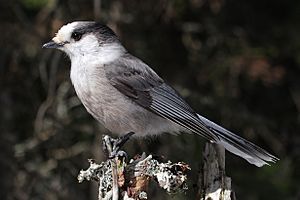
Canada is home to many different kinds of animals. There are about 200 types of mammals, over 460 bird species, more than 40 types of amphibians, over 40 reptile species, and over 1,200 kinds of fish. Plus, there are huge numbers of invertebrates like 55,000 insect species and 11,000 types of mites and spiders!
In the Great Lakes region, you can find animals like black bears, opossums, red squirrels, beavers, and skunks. Birds in this area include eastern bluebirds, red-winged blackbirds, and woodpeckers.
The boreal forest is home to moose, caribou, lynx, timber wolves, and porcupines. In the Rocky Mountains, you might see grizzly bears, mountain goats, wapiti, and cougars.
Along the Pacific coast, animals like the Cascade mountain goat and mountain beaver live. Birds here include the northern pygmy-owl and band-tailed pigeon. The Great Plains ecoregion has bison, desert cottontails, and different types of prairie dogs.
The cold Arctic is home to musk oxen, reindeer, polar bears, Arctic foxes, and arctic hares. Birds like the snowy owl and ptarmigan also live there.
Canada's oceans are full of life too! You can find walruses, dolphins, seals, sea turtles, whales, and sharks. Important fish for fishing include Atlantic cod and Pacific salmon. In freshwater, you'll find fish like walleye and northern pike. Canada also has many amphibians (like frogs and salamanders) and reptiles (like turtles and snakes).
Many birds from North America, like songbirds and waterfowl, come to Canada in the spring and summer to nest.
Wonderful Plants
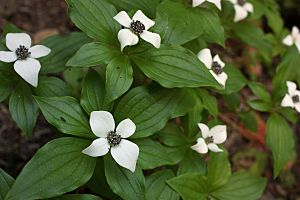
Canada has about 17,000 different types of plants. These include trees, flowers, herbs, ferns, and mosses. Most of Canada's plants (about 95%) are flowering plants.
About half of Canada is covered by forests, which is about 2.4 million square kilometers. Most of these forests (over 90%) are owned by the public. About half of the forests are used for logging.
In the Great Lakes region, you'll find trees like white pine, hemlock, and red maples. The eastern parts of Canada have trees like red spruce, black spruce, balsam fir, and white birch. The cold tundra has trees like aspen and balsam poplar.
On the west coast, you'll see large trees like western hemlock, red cedar, and douglas fir. The Rocky Mountains have alpine fir and engelmann spruce. Other native plants found across Canada include American Ginseng and purple prairie clover.
Species at Risk
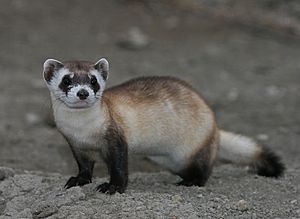
Canada has a law called the Species at Risk Act (SARA). This law helps protect wildlife from disappearing. Its main goal is to save endangered or threatened animals and plants, and their homes. Provinces and territories also have their own rules to protect species.
Even though Canada doesn't have as many unique species as some other countries, many are still in danger. Things like pollution, losing their homes, too much fishing or hunting, and invasive species (species from other places that cause harm) are big problems.
More than 800 species in Canada are at risk of extinction. This includes 363 species that are endangered (very high risk), 190 that are threatened (likely to become endangered), and 235 that are of special concern. Also, 22 species are "extirpated," meaning they no longer live in the wild in Canada.
Some animals at risk include the Canada lynx, polar bear, sea otter, wolverine, black-footed ferret, and whooping crane.
Sadly, at least 19 species have completely disappeared from Canada since Europeans arrived in the 1500s. This means over 30 types of plants and animals are gone forever. Examples include the dawson's caribou, sea mink, great auk, and passenger pigeon.
Invasive Species
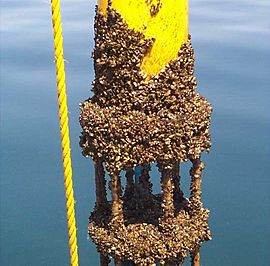
Over 1,400 invasive species have been brought to Canada. These include fish, plants, insects, and other small creatures. They arrived either on purpose or by accident. More than 450 invasive plants and 400 invasive insects have been found.
The Great Lakes region has almost 200 invasive species. This makes it one of the most affected areas in Canada. Freshwater areas are especially at risk compared to land areas.
Invasive species like the sea lamprey, zebra mussels, European green crab, and Asian carp can cause big problems. They change local habitats and can make native species disappear.
Some of the most harmful invasive plants are purple loosestrife, yellow iris, and leafy spurge. A fungus that causes Dutch elm disease is also a big problem. These species spread quickly and can take over areas, harming native plants and farm crops.
Invasive species cost Canada billions of dollars each year. This is due to losses in farming, forestry, and fishing. In 2004, it was estimated that the top 16 invasive species caused losses of $13 to $35 billion.
Protecting Wildlife
About 12.1% of Canada's land and freshwater are set aside for conservation. This includes 11.4% that are officially protected areas. Also, about 13.8% of Canada's ocean waters are conserved.
The amount of land protected has grown by 65% in the last 20 years. The amount of ocean protected has grown even more, by over 3,800%! These protected areas have different goals. Some focus on keeping nature healthy, others on history, public use, or scientific research.
Canada created the world's first national park management group, the Dominion Parks Branch (now Parks Canada), in 1911. In 1916, Canada and the United States signed a treaty to protect birds that migrate between the two countries. Other laws, like the Canada Wildlife Act (1973) and the Fisheries Act (1985), help protect wildlife and fish. The National Marine Conservation Areas Act (2002) created protected areas in the oceans.
The main goal of Canada's national parks is to keep their natural environments healthy. The Canadian Wildlife Service manages other protected areas like National Wildlife Areas and Migratory Bird Sanctuaries. Provinces and territories also have their own protected areas. Some areas, like Polar Bear Pass, are managed together by the government and local Indigenous groups.
Canada has 18 UNESCO Biosphere Reserves, covering a huge area of 235,000 square kilometers. Banff National Park, established in 1885, was Canada's first national park. It has mountains, glaciers, forests, and alpine areas. Algonquin Provincial Park, created in 1893, is Canada's oldest provincial park. It has old-growth forests, over 2,400 lakes, and many rivers.
The Lake Superior National Marine Conservation Area is the world's largest freshwater protected area. It covers about 10,000 square kilometers of the lake and its shoreline. Canada's largest national wildlife region is the Scott Islands Marine National Wildlife Area. It protects important breeding and nesting spots for over 40% of British Columbia's seabirds.
National Wildlife Symbols
Canada does not have a national flower or bird.
| Symbol | Image | Notes |
|---|---|---|
| Maple leaf |  Maple leaf |
This has been a symbol of Canada since the 1700s. |
| National flag |  |
Became official on February 15, 1965. It has a red maple leaf in the middle. |
| National tree | 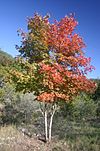 Maple |
Became an official symbol in 1996. |
| National animals |  Beaver |
Became an official symbol in 1975. |
 Canadian horse |
Became an official symbol in 2002. |
Provincial and Territorial Wildlife Symbols
Each Canadian province and territory has its own official animals, plants, and other symbols. These are chosen based on the unique nature of each area.
| Flower | Area | Plant (flower) | Tree | Mammal | Bird | Fish | Other |
|---|---|---|---|---|---|---|---|
 |
Alberta | Rosa acicularis (Prickly wild rose) | Lodgepole pine | Rocky Mountain bighorn sheep | Great horned owl | Bull trout | Rough fescue (Grass) |
 |
British Columbia | The Pacific dogwood, Cornus nuttallii | Western red cedar (Thuja plicata) | Spirit bear (kermode bear, Ursus americanus kermodei) | Steller's jay (Cyanacitta dtelleri) | Pacific salmon | |
 |
Manitoba | Prairie crocus (Pulsatilla patens) | White spruce (Picea glauca) | American bison (Bison bison) | Great gray owl (Strix nebulosa) | Walleye | Big bluestem (Grass) |
 |
Newfoundland and Labrador | Purple pitcher plant (Sarracenia purpurea) | Black spruce | Newfoundland dog | Atlantic puffin | ||
 |
Nova Scotia | Mayflower (Epigaea repens) | Red spruce (Picea rubens) | Nova Scotia duck tolling retriever dog
Provincial horse: Sable Island horse |
Osprey (Pandion haliaetus) | Wild Blueberry | |
 |
New Brunswick | Purple violet | Balsam fir | Black-capped chickadee | Holmesville Soil | ||
 |
Ontario | Trillium (Trillium grandiflorum) | Eastern white pine (Pinus strobus linnaeus) | Common loon (Gavia immer) | |||
 |
Prince Edward Island | Lady’s slipper (Cypripedium acaule) | Red oak (Quercus rubra) | Blue jay (Cyanocitta cristata) | Charlottetown soil | ||
 |
Quebec | Blue flag iris | Yellow birch | Snowy owl | |||
 |
Saskatchewan | Western red lily | White birch | White-tailed deer | Sharp-tailed grouse | Walleye | Needle-and-thread grass |
 |
Northwest Territories | Mountain avens | Tamarack (Larix laricina) | Gyrfalcon (Falco rusticolus) | Arctic grayling (Thymallus arcticus) | ||
 |
Nunavut | Purple saxifrage | Canadian Inuit Dog | Rock ptarmigan | |||
 |
Yukon | Fireweed (Epilobium angustifolium) | Subalpine fir (Abies lasiocarpa) | Raven (Corvus corax) |



